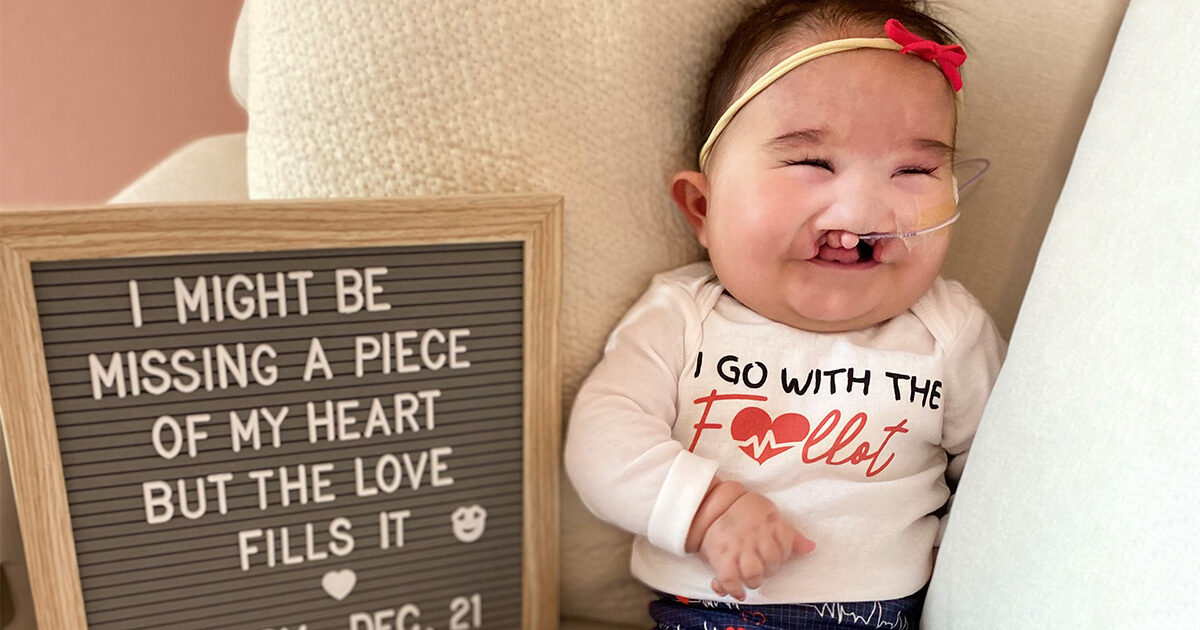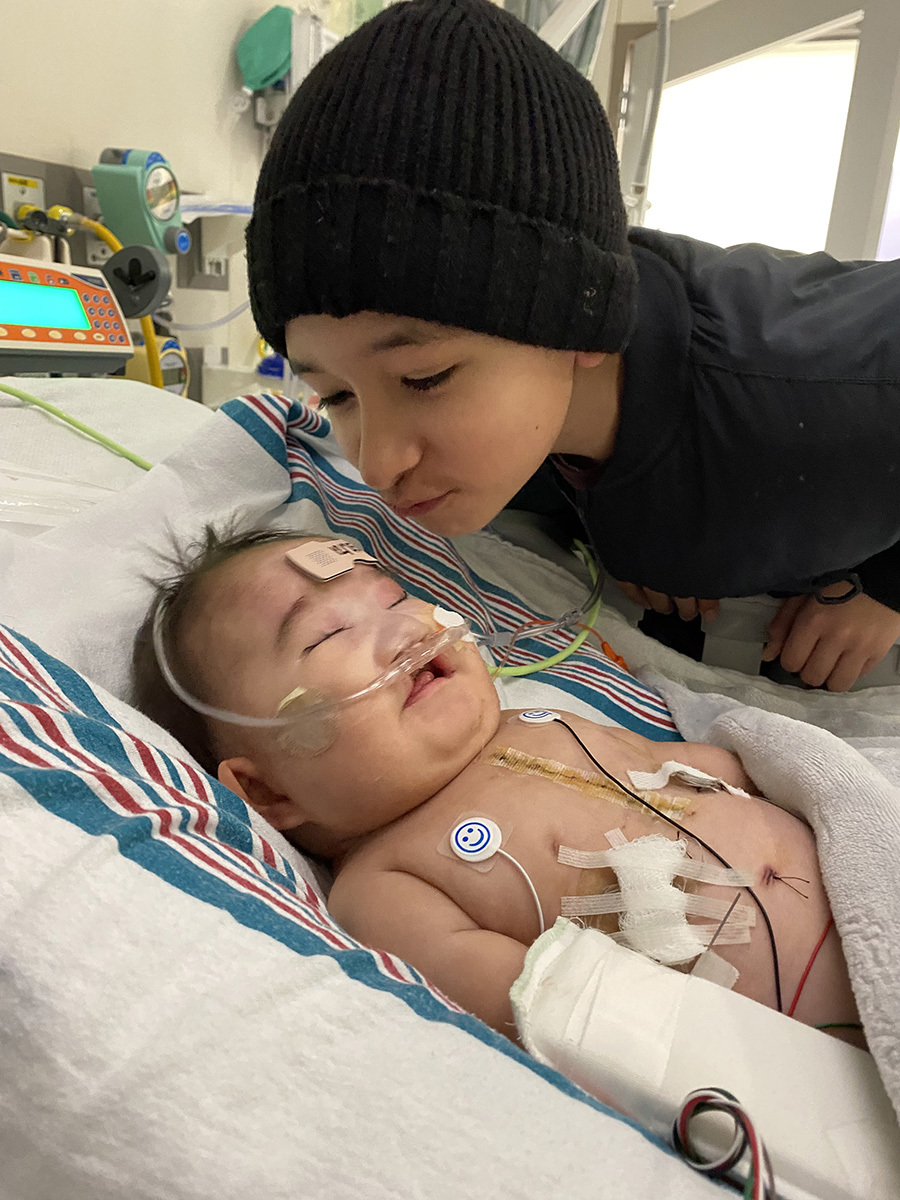Defying the Odds
UT Health Austin pediatric heart surgeon takes on seemingly impossible case without hesitation
Reviewed by: Linda and Robert Sedillo
Written by: Ashley Lawrence

At 16 weeks pregnant, Linda Sedillo underwent routine testing with her obstetrician-gynecologist, who revealed her test results showed possible signs of trisomy 13, a rare genetic condition associated with high mortality rates, a range of congenital abnormalities, and severe physical and cognitive impairment. Trisomy 13, also known as Patau’s syndrome, occurs when there is an extra copy of chromosome 13 in either the egg or sperm prior to conception, which leads to the baby having three copies of chromosome 13 instead of two. This condition develops by chance and is not caused by anything the mother did or did not do during pregnancy.
Many pregnancies with a diagnosis of trisomy 13 result in miscarriage, and most babies born with the condition will not survive more than a few days or weeks, with less than 10% of babies surviving their first year of life. Linda’s obstetrician-gynecologist referred her to a maternal-fetal medicine specialist, a highly specialized obstetrician-gynecologist that diagnoses, treats, and manages the care of expecting mothers with complex and high-risk pregnancies. Linda’s maternal-fetal medicine specialist confirmed her unborn baby was positive for trisomy 13.
As Linda’s visits continued with her maternal-fetal medicine specialist, her unborn baby was also diagnosed with a cleft lip and palate, a common condition that occurs when a baby’s lips and mouth do not form correctly during pregnancy, causing difficulty with speaking and eating, and a heart condition that required a referral to a pediatric cardiologist. Linda’s pediatric cardiologist confirmed a diagnosis of tetralogy of Fallot, a rare condition in which a combination of four structural heart defects (overriding aorta, pulmonary stenosis, right ventricular hypertrophy, and ventricular septal defect) occur at once, causing oxygen-poor blood to flow out of the heart and into the rest of the body.
“I had been pregnant twice before, but my entire pregnancy with Rubi was really hard,” shares Linda. “I was really careful not to strain myself. I was always tired and wasn’t even able to walk toward the end. I also tried to stay positive and hopeful despite being advised to consider not carrying to term and then being told that we may have a difficult time finding someone to perform my baby’s surgery once she was born. It was really the emotional aspect of everything that weighed on me the most. It definitely wasn’t Rubi, because she only weighed 4 pounds.”
Surviving the Unthinkable
On March 21, 2022, when Linda was 35 weeks along, Rubi Sedillo was born weighing 4 pounds, 3 ounces. “Rubi looked healthy overall to me,” says Linda. “Despite her low weight, she didn’t need oxygen or really anything special. The hospital staff expected Rubi to pass and didn’t want to do anything intrusive that could hurt her. We were able to take her home by mid-April.”
“Shortly after we brought Rubi home,” adds Robert Sedillo, Rubi’s father, “when she was just one month old, Rubi was having severe sleep apnea, where she would just stop breathing. But then, she would start again. This happened on and off for hours, and we thought we were going to lose her, so we decided to reach out to our church and begin making arrangements.”
Then, the unthinkable happened. On May 28, 2022, one day before her 19th birthday, Rubi’s older sister, Rachel Morales, unexpectedly passed in a fatal car accident. “Little did we know,” continues Robert, “the plans that we put in place the month before would be for Rachel.”

“Rachel was a rock for our 12-year-old son, Robert Jr.,” explains Linda. “Throughout my pregnancy and even after Rubi’s birth, I wasn’t able to spend as much time with him or do as much stuff with him. While we were focused on Rubi, Rachel made sure that he received the attention he deserved. They had a really close relationship and loved going to the movies together.”
Breaking Barriers in Heart Care
Determined to give Robert Sedillo, Jr. as much time as possible with his new baby sister, Linda and Robert revisited Rubi’s path to healing with her doctors. They were met with some resistance when various aspects of Rubi’s health couldn’t be addressed until her heart was fixed. When Rubi started experiencing tet spells, rapid drops in the amount oxygen in her blood due to her heart condition, Linda and Robert made the decision to pursue open-heart surgery to address Rubi’s heart defect. Finding a heart surgeon to take on Rubi’s case, however, was seemingly impossible.
“Our cardiologist knew we wanted to pursue surgery, but no one wanted to touch Rubi’s case,” says Linda. “We received automatic no after automatic no from multiple local surgeons who didn’t even look at Rubi’s file. The surgery was just too high of a risk. Weeks later, our cardiologist asked if we would be open to traveling further out, and we, of course, said yes. That’s when she reached out to Dr. Fraser, a former colleague of hers, at Dell Children’s. Without hesitation, Dr. Fraser agreed to take on Rubi’s case.”
Uncovering Care That Makes a Difference
On December 21, 2022, just two days before Robert Jr.’s 12th birthday and 9 months after Rubi’s birth, Rubi was strong enough to undergo open-heart surgery. Rubi’s surgery was led by UT Health Austin congenital heart surgeon Charles D. Fraser, Jr., MD, who serves as the Chief of Pediatric and Congenital Heart Surgery for the Texas Center for Pediatric and Congenital Heart Disease, a clinical partnership between Dell Children’s Medical Center and UT Health Austin.

“Dr. Fraser and his team have a very different mindset,” shares Robert. “As soon as we arrived at the heart center, there was this attitude of confidence among the providers that was contagious and even spilled over into Rubi. As they were wheeling her down the hall to surgery, Rubi was all smiles and laughing and moving around and had her arms up. We were reminded that Rubi is strong, and even though she was going into surgery, we didn’t feel this overwhelming need to be worried.”
“At the heart center, it felt like everyone was more attentive and that we were in a family environment, which is the complete opposite of what we experienced before,” adds Linda. “I felt very confident in the staff, and during Rubi’s surgery noticed that we were all just really calm and even hopeful. It felt like we weren’t scared because we knew that everything was going to be okay. We were so grateful that we found this amazing heart surgeon who was willing to repair our daughter’s heart and even just show us how special Rubi really is.”
“There is definitely a higher level of service at Dell Children’s,” continues Robert. “It’s apparent that Dr. Fraser and his team are really passionate about the work that they do. When discussing Rubi’s condition, they were adamant about not labeling her as her condition. They wanted us to understand that we don’t know what her life will consist of, so there’s no need to try to diminish that by seeing her solely through her condition. We can’t even tell you how much we appreciated that and how perfectly that lined up with what we want for Rubi as well.”
Becoming a Beacon of Hope
On January 4, 2023, two weeks after her surgery, Rubi was discharged from Dell Children’s Medical Center and allowed to return home, where she continues to receive care locally. For Linda and Robert, entrusting Rubi’s care to the Texas Center for Pediatric and Congenital Heart Disease has helped them become better advocates for their daughter’s health.
“Every day, we become more and more surprised by Rubi, and the doctors do, too,” says Robert. “Despite all the medication and issues listed out on paper, she looks like a regular baby. She’s always smiling, and we see a lot of Rachel in Rubi, especially in her eyes and when her personality really comes through.”
“Even when we took Rubi in for her follow-up appointment when we returned home, the doctors all commented on her progress and how well her scar is healing,” adds Linda. “Some providers even asked why we didn’t get care locally, and when we tell them that no one would do the surgery, they always look shocked. We hope that Rubi’s story changes the narrative for patient cases like hers in the future.”
“There are people out there who were diagnosed with trisomy 13 and lived to adulthood,” continues Linda. “It may be a small percentage, but you never know if your child is going to be a part of that percentage. From the beginning, we were told we were going to lose Rubi. I grieved her, and sometimes still do. Yet, it was out oldest daughter, who was the healthiest of all our kids, that we lost. My advice for other parents and families is to not assume the worst, always seek out a second and third opinion, and get connected with a support group that consists of other families who have experienced or who are going through the same thing as you. I’m very grateful that I was able to meet Rubi, and I’m grateful that she’s still here.”
Finding a Path Forward
“Thinking back on it, we initially appreciated the hospital’s transparency throughout Linda’s pregnancy and even after Rubi’s birth,” shares Robert. “We felt that they were being extremely nice to us by being honest and preparing us for the worst. It wasn’t until we met Dr. Fraser and his team at Dell Children’s that we realized they weren’t supporting us in any path forward for Rubi.”
Now that Rubi’s heart has been repaired, she will be able to move forward with other surgeries. Rubi is scheduled to undergo a gastrostomy tube (G-tube) placement on March 23, 2023 and a bilateral cleft lip and palate repair hopefully early next year.
“We’ve seen a lot of improvement with Rubi since her heart surgery,” adds Linda. “She doesn’t have tet spells anymore, she doesn’t cry as much, and she’s much more comfortable. We’re just so thankful that we got connected with the right care team.”
To learn more about the Texas Center for Pediatric and Congenital Heart Disease, please call 1-855-324-0091 or visit here.